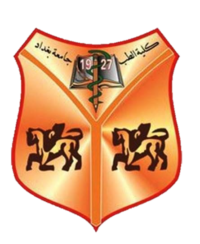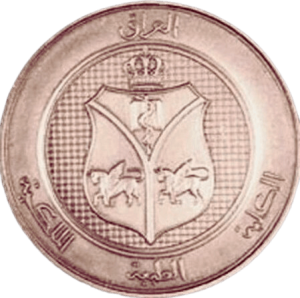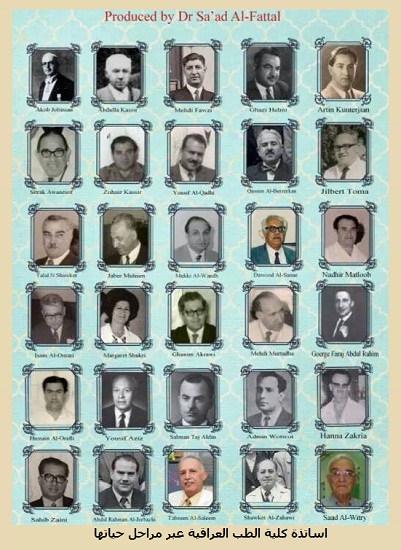The Foundation of the Iraqi Royal Medical College: A Unique Educational and Architectural Milestone
When the building of the Iraqi Royal Medical College was inaugurated on the 4th of April, 1930, at its location in Al-‘Aiwadiah (also pronounced as Al-‘Ilwaziah by the Baghdad elite, following the Ottoman spelling), the pioneering Al-Bayt University in our country had already been closed. In this peculiar paradox, the integration of the medical college into the organizational structure of Al-Bayt University on November 29, 1927, was considered the official date of the college's establishment. This establishment has always been regarded as a unique and exceptional event of great importance, both for the trajectory of Iraqi education and for the advancement of healthcare in the country.
The architect Harold Clifford Mason (1892–1960), known as H.C. Mason, who served as the Government Architect in the Directorate of Public Works (and not Wilson, as commonly assumed), was tasked with designing the college in late 1927. He selected a site belonging to the religious endowments (Awqaf), adjacent to the Royal Hospital, aligning with the model of other reputable medical colleges that utilized nearby hospital wards as classrooms and spaces for practical training required throughout students’ academic years.
Mason understood the modest financial allocation for the college but was equally aware of the unique architectural challenge he was entrusted with. He approached it as a design theme that introduced novel and unfamiliar educational dimensions directly tied to public health in a country that had neither recent nor distant historical precedent for such an educational undertaking.



![احتفالية-1024x686[1]](https://en.comed.uobaghdad.edu.iq/wp-content/uploads/sites/94/2025/01/احتفالية-1024x6861-1-600x402.jpg)
![واجهة-الكلية-1024x606[1]](https://en.comed.uobaghdad.edu.iq/wp-content/uploads/sites/94/2025/01/واجهة-الكلية-1024x6061-1-600x355.jpg)
![59508ccfd-137495[1]](https://en.comed.uobaghdad.edu.iq/wp-content/uploads/sites/94/2025/01/59508ccfd-1374951-600x337.jpg)
![1569d2b8ac81b46ed6c68f9bf0e3c0e7-baghdad[1]](https://en.comed.uobaghdad.edu.iq/wp-content/uploads/sites/94/2025/01/1569d2b8ac81b46ed6c68f9bf0e3c0e7-baghdad1-600x369.jpg)
![ExZp4p0XIAUv4Eu[1]](https://en.comed.uobaghdad.edu.iq/wp-content/uploads/sites/94/2025/01/ExZp4p0XIAUv4Eu1-600x364.jpg)
![DfGJ5n6W0AEZf7-[1]](https://en.comed.uobaghdad.edu.iq/wp-content/uploads/sites/94/2025/01/DfGJ5n6W0AEZf7-1.jpeg)
![قاعة-الدرس-1024x634[1]](https://en.comed.uobaghdad.edu.iq/wp-content/uploads/sites/94/2025/01/قاعة-الدرس-1024x6341-1-600x371.jpg)
![DfGJ5nlW4AEt52q[1]](https://en.comed.uobaghdad.edu.iq/wp-content/uploads/sites/94/2025/01/DfGJ5nlW4AEt52q1.jpeg)
![DfGJ5nkW0AIXPmA[1]](https://en.comed.uobaghdad.edu.iq/wp-content/uploads/sites/94/2025/01/DfGJ5nkW0AIXPmA1-600x449.jpeg)
![التشريح-1024x619[1]](https://en.comed.uobaghdad.edu.iq/wp-content/uploads/sites/94/2025/01/التشريح-1024x6191-1-600x363.jpg)
![DfGJ5noXkAA7ucZ[1]](https://en.comed.uobaghdad.edu.iq/wp-content/uploads/sites/94/2025/01/DfGJ5noXkAA7ucZ1.jpeg)
![متحف-1024x652[1]](https://en.comed.uobaghdad.edu.iq/wp-content/uploads/sites/94/2025/01/متحف-1024x6521-1-600x382.jpg)
![مختبر-الباثولوجي-1024x615[1]](https://en.comed.uobaghdad.edu.iq/wp-content/uploads/sites/94/2025/01/مختبر-الباثولوجي-1024x6151-1-600x360.jpg)
![مختبر-الكلية-1024x755[1]](https://en.comed.uobaghdad.edu.iq/wp-content/uploads/sites/94/2025/01/مختبر-الكلية-1024x7551-1-600x442.jpg)
![محتبر-الكيمياء-1024x610[1]](https://en.comed.uobaghdad.edu.iq/wp-content/uploads/sites/94/2025/01/محتبر-الكيمياء-1024x6101-1-600x357.jpg)
![منظر-جوي-للكلية-1024x610[1]](https://en.comed.uobaghdad.edu.iq/wp-content/uploads/sites/94/2025/01/منظر-جوي-للكلية-1024x6101-1-600x357.jpg)
![FB_IMG_1719427883192[1]](https://en.comed.uobaghdad.edu.iq/wp-content/uploads/sites/94/2025/01/FB_IMG_17194278831921-600x379.jpg)
![IMG_2181[1]](https://en.comed.uobaghdad.edu.iq/wp-content/uploads/sites/94/2025/01/IMG_21811-600x392.jpg)
![مستشفى-الملكي[1]](https://en.comed.uobaghdad.edu.iq/wp-content/uploads/sites/94/2025/01/مستشفى-الملكي1-600x453.jpg)
![مستشفى-المجيدية[1]](https://en.comed.uobaghdad.edu.iq/wp-content/uploads/sites/94/2025/01/مستشفى-المجيدية1.png)
![images-1[1]](https://en.comed.uobaghdad.edu.iq/wp-content/uploads/sites/94/2025/01/images-11.jpeg)
![IMG_2179[1]](https://en.comed.uobaghdad.edu.iq/wp-content/uploads/sites/94/2025/01/IMG_21791-600x338.jpg)
![250px-الدكتور_سلمان_فائق_في_بغداد_عام_1933[1]](https://en.comed.uobaghdad.edu.iq/wp-content/uploads/sites/94/2025/01/250px-الدكتور_سلمان_فائق_في_بغداد_عام_19331.jpg)
![كلية-الطب1[1]](https://en.comed.uobaghdad.edu.iq/wp-content/uploads/sites/94/2025/01/كلية-الطب11.jpg)
![شهادة[1]](https://en.comed.uobaghdad.edu.iq/wp-content/uploads/sites/94/2025/01/شهادة1-600x499.jpg)
![IMG-a1d22f289334b5d726049ff5704ecee5-V-570x1024[1]](https://en.comed.uobaghdad.edu.iq/wp-content/uploads/sites/94/2025/01/IMG-a1d22f289334b5d726049ff5704ecee5-V-570x10241-1.jpg)
![IMG-c7f2706707d5c47e8a9dde7fd8266cf2-V-1024x794[1]](https://en.comed.uobaghdad.edu.iq/wp-content/uploads/sites/94/2025/01/IMG-c7f2706707d5c47e8a9dde7fd8266cf2-V-1024x7941-1-600x465.jpg)
![IMG-c12b29da0499c1bf79fcada1744944e4-V-1024x935[1]](https://en.comed.uobaghdad.edu.iq/wp-content/uploads/sites/94/2025/01/IMG-c12b29da0499c1bf79fcada1744944e4-V-1024x9351-1-600x548.jpg)
![IMG-e4ebef20a678049c5b9f5ce2aa3a4cf4-V-829x1024[1]](https://en.comed.uobaghdad.edu.iq/wp-content/uploads/sites/94/2025/01/IMG-e4ebef20a678049c5b9f5ce2aa3a4cf4-V-829x10241-1-600x741.jpg)
![مجلة-كلية[1]](https://en.comed.uobaghdad.edu.iq/wp-content/uploads/sites/94/2025/01/مجلة-كلية1.jpg)
![حفل[1]](https://en.comed.uobaghdad.edu.iq/wp-content/uploads/sites/94/2025/01/حفل1.jpg)
![اطباء-583x1024[1]](https://en.comed.uobaghdad.edu.iq/wp-content/uploads/sites/94/2025/01/اطباء-583x10241-1.jpg)
![IMG-1595d6a377a20ff923e52b2d7acb6127-V-1024x666[1]](https://en.comed.uobaghdad.edu.iq/wp-content/uploads/sites/94/2025/01/IMG-1595d6a377a20ff923e52b2d7acb6127-V-1024x6661-1-600x390.jpg)
![IMG_2174-1024x676[1]](https://en.comed.uobaghdad.edu.iq/wp-content/uploads/sites/94/2025/01/IMG_2174-1024x6761-1-600x396.jpg)
![Screenshot_20240430_002902_Instagram-1024x848[1]](https://en.comed.uobaghdad.edu.iq/wp-content/uploads/sites/94/2025/01/Screenshot_20240430_002902_Instagram-1024x8481-1-600x497.jpg)
![خريجي-1024x634[1]](https://en.comed.uobaghdad.edu.iq/wp-content/uploads/sites/94/2025/01/خريجي-1024x6341-1-600x371.jpg)
![1941-2[1]](https://en.comed.uobaghdad.edu.iq/wp-content/uploads/sites/94/2025/01/1941-21.jpg)
![1941-3[1]](https://en.comed.uobaghdad.edu.iq/wp-content/uploads/sites/94/2025/01/1941-31.jpg)
![IMG-54f366f9d9f9a3b338d974c7f0e11042-V[1]](https://en.comed.uobaghdad.edu.iq/wp-content/uploads/sites/94/2025/01/IMG-54f366f9d9f9a3b338d974c7f0e11042-V1-600x570.jpg)
![IMG-757db9127b1d1576dff8252de846bfae-V[1]](https://en.comed.uobaghdad.edu.iq/wp-content/uploads/sites/94/2025/01/IMG-757db9127b1d1576dff8252de846bfae-V1-600x370.jpg)
![IMG_20151124_233040[1]](https://en.comed.uobaghdad.edu.iq/wp-content/uploads/sites/94/2025/01/IMG_20151124_2330401-600x426.jpg)
![النادي[1]](https://en.comed.uobaghdad.edu.iq/wp-content/uploads/sites/94/2025/01/النادي1.jpg)
![1-[1]](https://en.comed.uobaghdad.edu.iq/wp-content/uploads/sites/94/2025/01/1-1.jpg)
![اساتذة-الكلية-عبر-التاريخ[1]](https://en.comed.uobaghdad.edu.iq/wp-content/uploads/sites/94/2025/01/اساتذة-الكلية-عبر-التاريخ1.jpg)
![اساتذة-الكلية-عبر-التاريخ2[1]](https://en.comed.uobaghdad.edu.iq/wp-content/uploads/sites/94/2025/01/اساتذة-الكلية-عبر-التاريخ21.jpg)
